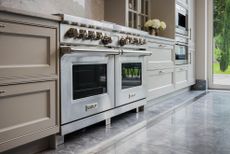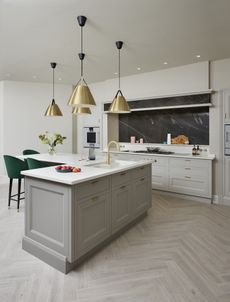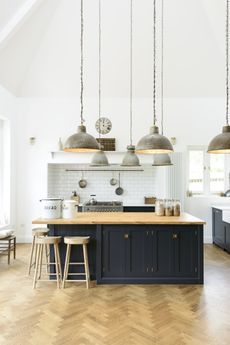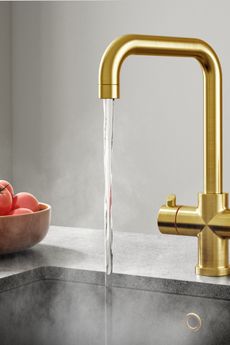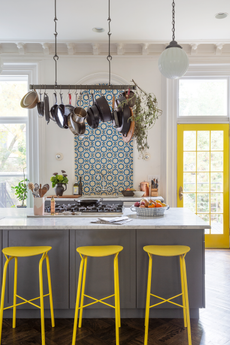Six Steps to a Dream Kitchen
1 start early
Engage a kitchen designer early so that structural work and services are planned well in advance. ‘If you need power to an island for example, your designer will ensure this is installed before the flooring,’ says DanielaCondo, kitchen designer at Life Kitchens.
Think about structural work needed at the initial stages to ensure your project runs smoothly and to budget as well.

2 work smart
Plan what goes where. The traditional ‘working triangle’, where the fridge, hob/oven and sink are arranged in a triangle formation, is a good rule of thumb. ‘The idea is to have a clear path between the keyelements, so that they’re easily accessible and not blocked by obstacles,’ explains Andy Briggs, interior designer at Optiplan Kitchens.
Ensure there’s enough space to move freely through your kitchen, adds Ashleigh Hanwell, senior designer at Second Nature. ‘Whether it’s a walkway between units in a galley layout, or the space around an island, we recommend leaving between 900 and 1,000mm between units.’

3 light up
‘Often overlooked during the design stage, lighting should be incorporated right from the beginning,’ stresses Darren Watts, design director at Wren Kitchens. Start by working out where you need lighting most– for example, beneath wall cabinets to illuminate the worktop, above the sink to make sure you can see to wash up or inside cabinets to subtly illuminate the contents, making things easier to find.

See more kitchen lighting ideas.
4 cupboard love
Storage is essential to the smooth running of a kitchen, so take note of what works in your existing space and how it might be improved. Savvy updates include floor-to-ceiling units fitted with racks ordrawer boxes that pull out.
‘Tall units will not only accentuate the height of the room, but they’ll also allow you to store rarely used items at the top, with commonly used items at eye level,’ says Andy Briggs, interior designer at Optiplan Kitchens.

5 get floored
Performance is key when you’re considering flooring. ‘For busy, hard-working kitchens, we would recommend durable flooring such as limestone,’says Louisa Eggleston, creative director at Humphrey Munson.
Think practically, too: ‘Be aware that grout changes colour quickly,’says Helen Flanagan, kitchen designer for Harvey Jones. ‘I would opt for a dark grey grout, as it will end up this colour anyway over time.’

6 on the surface
It’s wise to spend as much as you can afford on worktops, as they’re likely to get the most wear. ‘You will need a surface that’s durable, easy to clean and heat resistant,’ says Jonathan Stanley, vice president ofmarketing at Caesarstone.
Don’t forget practicalities such as aftercare. ‘Marble is beautiful but is more susceptible to stains, while zinc or copper will change with wear, creating a beautiful patina,’ says Ben Burbidge, managing director at Kitchen Makers.

Find more ideas for kitchen worktops here.
Be The First To Know
The Livingetc newsletter is your shortcut to the now and the next in home design. Subscribe today to receive a stunning free 200-page book of the best homes from around the world.
Jacky Parker is a London-based freelance journalist and content creator, specialising in interiors, travel and food. From buying guides and real home case studies to shopping and news pages, she produces a wide range of features for national magazines and SEO content for websites
A long-time contributor to Livingetc, as a member of the team, she regularly reports on the latest trends, speaking to experts and discovering the latest tips. Jacky has also written for other publications such as Homes and Gardens, Ideal Home, Red, Grand Designs, Sunday Times Style and AD, Country Homes and Interiors and ELLE Decoration.
-
 The 12 Best Table Lamps for Reading —I'm a Certified Bookworm (and Shopping Expert)
The 12 Best Table Lamps for Reading —I'm a Certified Bookworm (and Shopping Expert)When it comes to table lamps for reading, I don't mess around. If you're the same, this edit is for YOU (and your books, or course — and good recommendations?)
By Brigid Kennedy Published
-
 "It's Scandi Meets Californian-Cool" — The New Anthro Collab With Katie Hodges Hits Just the Right Style Note
"It's Scandi Meets Californian-Cool" — The New Anthro Collab With Katie Hodges Hits Just the Right Style NoteThe LA-based interior designer merges coastal cool with Scandinavian simplicity for a delightfully lived-in collection of elevated home furnishings
By Julia Demer Published
-
 Buying a used kitchen could be your savviest design idea - here's what you need to know
Buying a used kitchen could be your savviest design idea - here's what you need to knowBuying an ex-display used kitchen is a way to a high-end home at High Street prices
By Jacky Parker Published
-
 How much does a kitchen island cost?
How much does a kitchen island cost?Dreaming of a kitchen island? Well, here are some practical pointers to help you budget and get an island ticked off your wish list
By Yvette Murrell Published
-
 How to design and install a kitchen island - experts share their tips
How to design and install a kitchen island - experts share their tipsThis handy guide on how to design and install a kitchen island includes everything you need to know
By sallynarraway Last updated
-
 Matte Black Taps And Granite Sinks: 3 Tips For Cleaning Your Design-Led Kitchen Features
Matte Black Taps And Granite Sinks: 3 Tips For Cleaning Your Design-Led Kitchen FeaturesWant to keep your designer kitchen looking it's best? We spoke to some experts and it turns out that all-natural is all you need...
By Ruth Doherty Published
-
 KITCHEN ESSENTIALS FROM A CELEBRATED COOK
KITCHEN ESSENTIALS FROM A CELEBRATED COOKWho better than celebrated food writer and avid cook Diana Henry to advise on the perfect kitchen?
By Pip Rich Last updated


